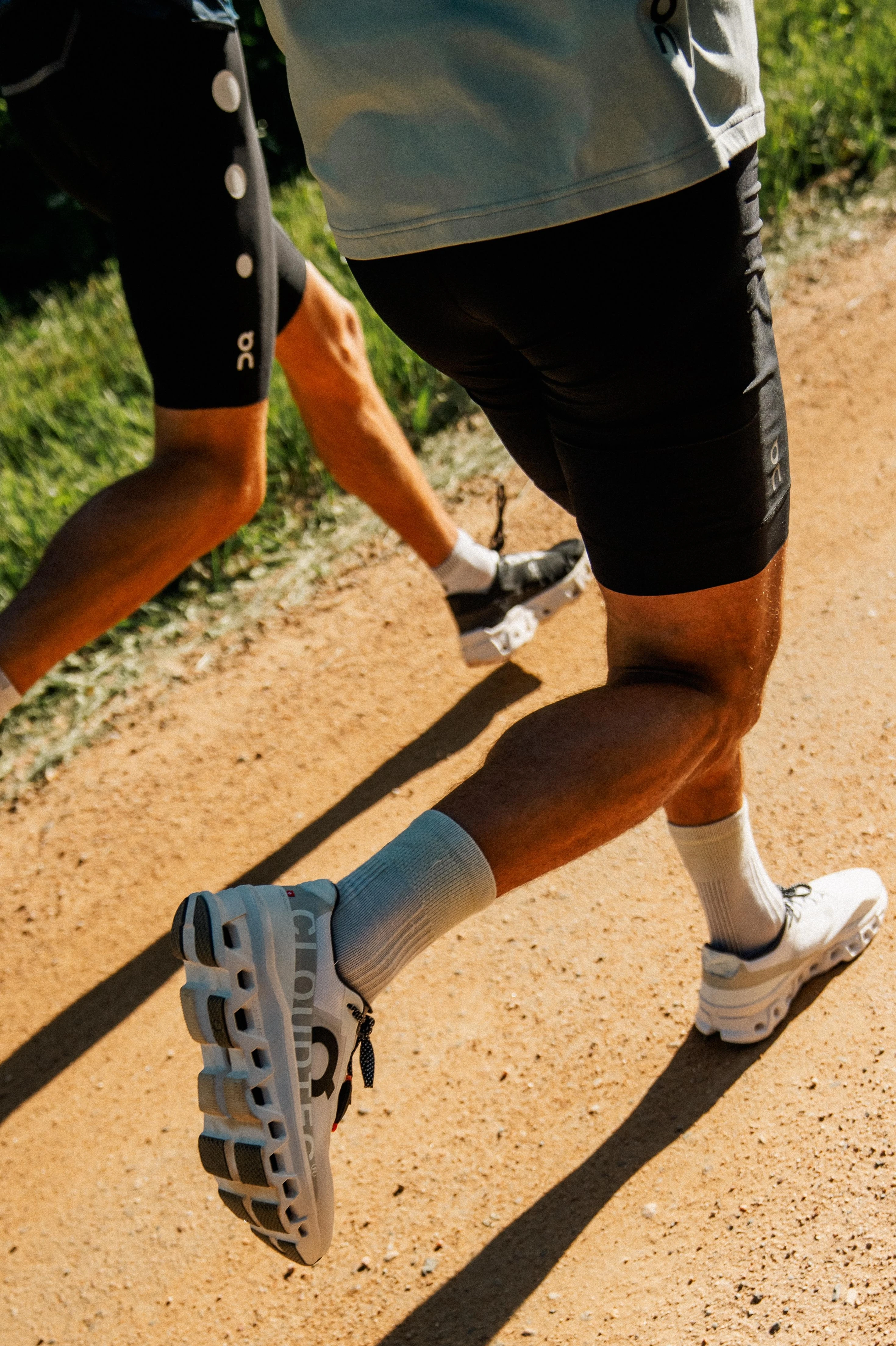It’s true: easy runs help make you faster on race day and support your recovery. Head Coach for the On Athletics Club (OAC), Dathan Ritzenhein, explains why you should slow down.
Words by Laura Markwardt. Photography by Colin Wong and Daniel Shea.
What does run slow to run fast mean?
While low-intensity “zone 2” training may be trending as the latest, technical-sounding fitness hack, professional endurance athletes and elite coaches have long been proponents of an easy, steady run.
Running slow to run fast simply means doing the highest volume of your running at an easy pace. The reality is that even elite distance runners don’t push themselves to superhuman cadence every time they lace up.
On athlete and distance runner, Verity Ockenden, finished her 2023 season with a career high – top ten in the 5km at the World Championships in Riga.
In the months leading up to this, her training varied in speed, with most of her runs coming in at least two minutes slower per kilometer than her race pace. The insight in action here: Fast runners don’t train at the same (high) intensity every time they run. And the science shows that you don’t need to, either.
If anything, the elite experts point out that even the best runners have a tendency to train at an intensity that slows their recovery. Head Coach for the On Athletics Club (OAC) and three-time US Olympian, Dathan Ritzenhein, explains, “A lot of athletes over-train, they overextend themselves on the easy days. Making your hard days hard is important. But then listening to your body on the easy runs so that you're ready for the next quality day is important.”
Why should I run slowly?
“You should run slowly because if you do too many of your fast runs in a row, you're going to dig yourself into a hole,” Coach Ritzenhein says.
“The aim is to balance your training between days that count to get better on the high end – coaches call it ‘raising your capacity’ – and then absorbing that effort to recover for the next run. You should have a good balance between those sessions.”
Here, it’s useful to understand the difference between aerobic and anaerobic training: Aerobic activity is defined by the American College of Sports Medicine (ASCM) as, “any activity that uses large muscle groups, can be maintained continuously and is rhythmic in nature.” The key word in the definition here is “continuously.”
Aerobic running is easy running at below 80 percent of your maximum heart rate. Running in this aerobic zone maximizes an athlete’s ability to burn fat as a fuel source. It’s running at the kind of pace where you think you could go forever.
In the aerobic zone, your body uses oxygen to power the muscles, fueling them with both glycogen (carbohydrate stored in the muscles) and fat (its preferred energy source). With this power-cocktail of fuel, your muscles can keep going. And that feels good.
In contrast, anaerobic training is what happens when you kick the intensity up a few gears. The ASCM defines it as “intense physical activity of very short duration, fueled by the energy sources within the contracting muscles and independent of the use of inhaled oxygen as an energy source.”
The anaerobic zone feels like running out of your comfort zone and into the hurt locker at a pace you know can’t sustain for long.
“Making your hard days hard is important. But then listening to your body on the easy runs so that you're ready for the next quality day is important.”
In anaerobic training, which powers the muscles without oxygen, the primary energy source for your muscles is glycogen, and the body’s glycogen reserves are used up much faster than its fat stores. If you push yourself into the anaerobic zone, you’ll eventually run out of glycogen. This is sometimes called ‘hitting the wall’ or ‘bonking’ – the state every runner dreads on race day.
Entering an anaerobic state is also the point where lactic acid starts to build up in the muscles. This biological mechanism prevents pushing your muscles beyond their limits by slowing you down. It’s a clever evolutionary trick, but it could stop you getting over the line on race day if you set off at a pace you can’t sustain.
Long-distance athletes (and runners training for marathons), need to perform in the aerobic zone for as long as possible on race day. This means training in the aerobic zone to move faster by efficiently burning fat without gobbling glycogen.
There’s truth to the old running adage, “Take the easy days easy and the hard days hard.”
While there are certainly benefits to getting out there no matter the pace, the respective training benefits of aerobic and anaerobic training come more efficiently when you focus on one or the other in each session.
Running slowly can boost your personal best if you run most of your miles at easier paces, interspersing this aerobic training with some out-of-the-comfort zone efforts.
Coach Ritzenhein recommends a training plan for best results: “If you run slow all the time and you never run fast, you probably won't reach your potential. That said, you have to make sure that you build in some easy days. The best thing to do is to plot out a weekly training plan where you have quality days. OAC athletes go two to three quality days that are faster, and then the other days are easy based on feel.”
How slow should I run?
The right pace for your aerobic workout means being able to run a fair distance at a comfortable pace.
Coach Ritzenhein explains there’s some nuance to this: “It definitely depends on the person, but some people use GPS watches, heart rate monitors or apps to track how slow their pace should be. I would say that conversational running is important for the easy days. So if you go for a run with someone else, make sure you can hold a conversation.”
To define it through data, staying in the aerobic zone means keeping your heart rate at no more than 80 percent of your max while you run. Most smartwatches will do these calculations for you by defining clear zones, but you can also work this out with a heart rate monitor.
To estimate your maximum heart rate, simply subtract your age from 220. For example, a 30-year-old would be at approximately 190 beats per minute as a maximum heart rate.
Once you know your max, you can work backwards to determine your heart rate zone. To improve aerobic performance, staying in the first three zones, as defined below, is suggested:
How to run slower
Applying heart rate zones to pacing recommendations means that most of your running won’t be above zone three.
To ensure you’re not creeping into the anaerobic heart rate zone four, it can be good to vary the pacing of your aerobic runs. On the days following a hard aerobic session, for example, staying in zones one and two will support your recovery.
Creeping into low zone four is not where you want to be regularly – save those anaerobic efforts for the intentionally tough workouts.
Also beware of running your easy days with groups or faster training partners: “Lots of people struggle by running too fast with others. It can be a good idea to tell the other people you're running with that the session is a recovery run for you,” says Coach Ritzenhein. “You want to target whatever your recovery pace is, and then hold yourself to account.”
Is it better to run fast or run slow?
If you’re used to just running by feel, you may have trouble keeping in the lower heart rate zones and find yourself subconsciously picking up the pace.
OAC Assistant Coach, Kelsey Quinn, explains: “You can look at the research and the training of elites from all over the world for years, but you can't just apply the same training model directly to any athlete and get the best results. There's a case-by-case nuance to it.”
At a broader, non elite-level, this means that your zone three may be different to others. And as 2018 Ironman World Championships runner-up Bart Aernouts explained when he stopped by On HQ, “a slow run can only be too fast, not too slow.”
Aernout’s really easy runs are paced between 6:54/mile (4:17/km) and 8:03/mile (5:00/km). That’s fast for an everyday runner, but it’s relative, and doesn't take him beyond zone three compared to his race pace.
Aernout’s philosophy is that doing more work (high volume) at lower intensities brings benefits. Training at low intensity more regularly, also means you’re less likely to get injured. While others may be recovering after a marathon, Bart can still train, leading to a higher volume of distance overall.
“You want to target whatever your recovery pace is, and then hold yourself to account.”
As any elite coach will tell you, taking recovery seriously is part of the training. Slower running is both a big part of optimized endurance training, and optimizing the recovery that follows. Coach Ritzenhein says: “Build in the days that matter. I suggest that both professional runners, and beginner runners plan a couple of days a week that are devoted to quality running, and the other days are focused on recovery and for building your aerobic capacity.”
Should you run slower to get faster?
Fitness benefits also come from the more focused speed sessions Coach Ritzenhein refers to. Occasional anaerobic workouts build the strength and power that you want to have in your arsenal, especially as you cruise into the final stages of a race – but remember to take the easy runs easy.
This introduction to interval training explains more about anaerobic intervals. If you’re looking to improve your speed running or run at a faster pace overall, then check out these tips on how to run at your fastest.
As the experts agree, adding more easy runs to your repertoire could be the key to unlocking the endurance and occasional high speed you need for a new personal best, all while enhancing recovery and limiting the likelihood of injury.
Slow and steady – most of the time – really does win the race.











